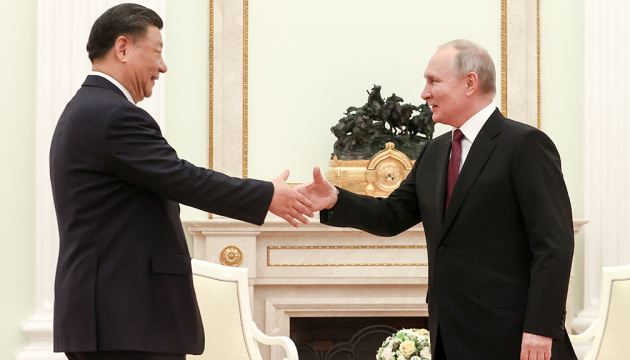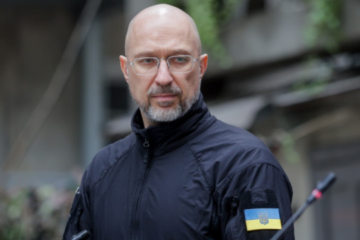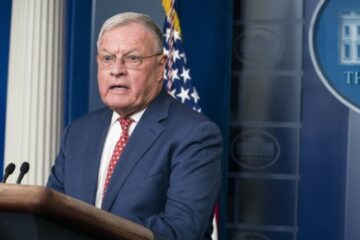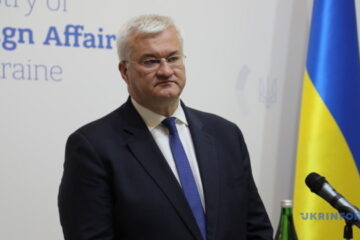Beijing has assigned Russia the role of thorn in the flesh and troublemaker for Washington
The Chinese leader has recently visited the Russian capital, where he behaved like the host and leader of a major power that is poised to challenge the United States’ posture as global leader. Beijing has assigned Russia the role of thorn in the flesh and troublemaker for Washington
INFORMAL PROTOCOL
Over decades of Xi Jinping and Vladimir Putin leading their respective countries, a special “chemistry” has developed in relations between them, and several informal protocol rules have emerged. One such is that leaders, after three rounds of official negotiations as part of delegations, meet again “without ties on” for tea in a narrow circle or vis-à-vis to talk over the most important issues. Another one is to travel to each other once in every two years for state visits, held at the highest status and with ceremonial pomp. The Chinese leader visits Moscow in odd-numbered years, while the Russian ruler travels to Beijing in even-numbered years.
This was the case in 2022, when Putin arrived in Beijing for the Winter Olympics opening ceremony on February 4, less than three weeks before his army invaded Ukraine. That visit was significant in that Beijing and Moscow signed a treaty on a strategic partnership “without limits,” effectively creating an alliance of two countries united by a common desire to undermine Western leadership of the liberal international order and set up new rules of international coexistence.
It was very soon that Ukraine and the world would learn what these rules should be like in the Kremlin’s view, in the early hours of the morning of February 24, when lengthy military vehicle convoys from the world’s largest country invaded a neighboring country almost 30 times smaller. The world was faced with a brutal attempt to return to the imperial past, when large countries conquered smaller neighbors and were imposing their rules of life on them.

Xi Jinping, 2023
Xi’s regular visit to Russia in March 2023 was of exceptional importance for both countries, but primarily for Moscow. At that time, the situation for the Kremlin’s owner was developing unfavorably – the Ukrainians had carried out a series of successful counterattacks and regained control over Kherson city and most of the Kharkiv region and were preparing for a new counteroffensive, while the U.S. Congress was voting for new aid packages for Ukraine. At that time, a military coup led by Yevgeny Prigozhin, leader of the Wagner private military group, had yet to take place, and the so-called “special military operation” was clearly not proceeding to plan despite the Kremlin consistently increasing its defense and war spending.
During that Moscow trip by the Chinese leader, few documents were formally signed, but key agreements were concluded behind closed doors, which became a lifeline for the Putin regime that effectively helped it stay afloat. At that time, Beijing had actually turned on the aid tap to the Russian defense-industrial sector as China launched massive supplies of industrial tooling machines suitable for production of weapons, along with chemical and other dual-capability products to defense industries in Russia. With these supplies, Moscow managed to stabilize production of weapons and ammunition and continue the war with renewed vigor.
The Chinese authorities also permitted Russia to use the yuan in foreign trade settlements and significantly increase supplies of oil, gas and other resources as well Russian products to China. Thus, Russia, under sanctions, was able to offset to a significant degree the negative impact of Western restrictions and keep its budget revenues at a level that allowed it to continue its aggression against Ukraine and maintain stability within the country.
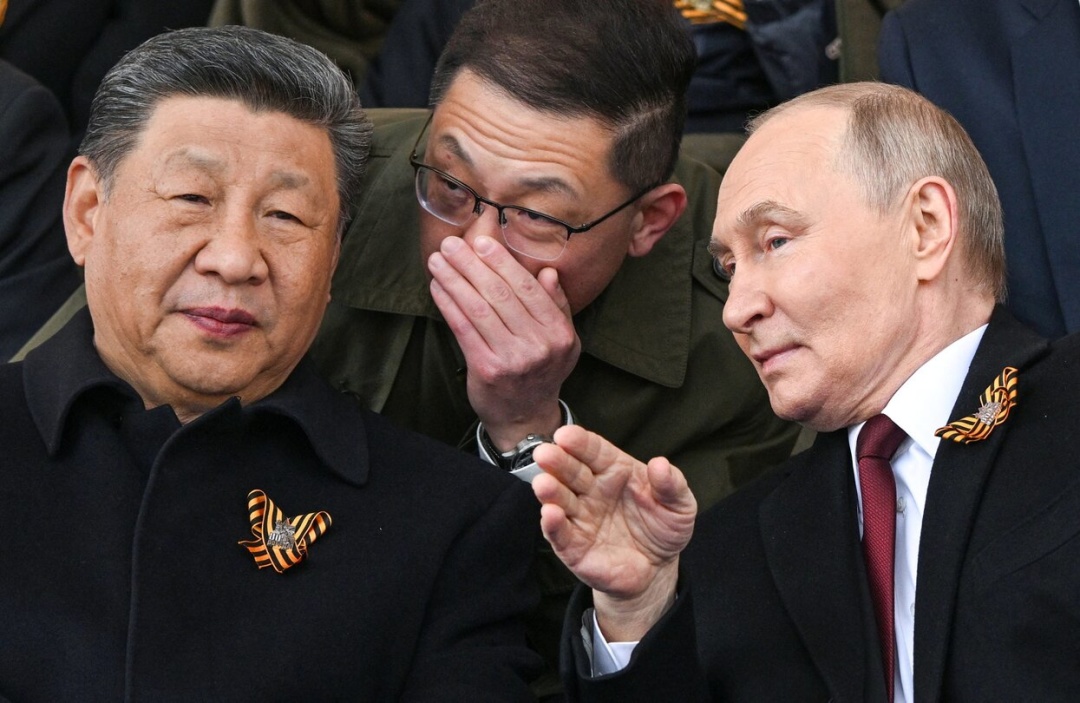
Xi Jinping and Putin at the Victort Day parade, Moscow, May 9, 2025
Xi’s most recent visit to Moscow, his 11th since taking office as Chinese leader in 2013, was, like Putin’s previous visit to Beijing in May last year, much less significant. It re-affirmed the “iron friendship” between the leaders of the two countries and can be seen as a tribute to informal protocol and an investment in Putin’s upcoming trip to China in September, when the PRC will celebrate the 80th anniversary of the victory of the Chinese People’s War of Resistance against Japanese Aggression. The Kremlin’s owner is likely to be the only leader of a major country with a permanent seat on the UN Security Council to attend the upcoming celebrations and will continue to persuade Chinese partners to spit on the sanctions and trade with his Russia.
PHOTO SESSIONS INSTEAD OF CHINESE MONEY
In Moscow, the Chinese leader received the highest honors – a guard of honor, fireworks, orchestra, a red carpet in the glittering reception hall of the Kremlin, dozens of cameras, and the central place on the Podium of the Mausoleum during the Victory Parade. This grandeur of the setting and the Kremlin owner’s enthusiastic hospitality in dealing with Xi have become casual and are no longer surprising.
The official outcomes of the talks were likewise modest: the two major countries and strategic partners “without limits” drew up 28 secondary documents for the meeting of their leaders, which were ceremoniously signed in their presence. Among the documents were three political statements, several protocols on phytosanitary control of Russian products, and fourteen memorandums of understanding on cooperation between universities and media outlets of the two countries, but not a single agreement on economic cooperation or investments was signed.
Moscow does not hide its desire to welcome investors from China, because bilateral Sino-Russian trade, which has been breaking records since the time the war began, is only sufficient to solve the current problems of the Russian economy, while investments would contribute to its sustainability in the future. The Chinese, however, are trading while not being too enthusiastic about investing in Russia, and this cannot but worry the Kremlin.
That said, an intergovernmental agreement on the facilitation and mutual protection of investments appeared among the signed documents, which raised eyebrows given that it was signed only now but not earlier. Didn’t China and Russia think about investing in each other’s projects before 2025? Well, they signed it and did well, but there should no expectations that Chinese investments will pour into Russia tomorrow.
Everything will apparently remain as it is, without any changes taking place and with zero investments flowing in, and bilateral trade, which jumped to record high of nearly 245 billion USD last year, may begin to decline. According to statistics for Q1 2025, trade between the two countries fell down by approximately 7 percent year-on-year, which may be due to seasonal fluctuations, or may as well mark the beginning of a downward trend.
Western economy analysts are saying that bilateral trade between China and Russia has already reached a plateau and may continue to grow modestly, or, most likely, will begin to decline. Therefore, the governments of the two countries will have to stabilize bilateral trade and keep it at the current level while simultaneously resolving current issues involved in improving the trade and investment environment that was formed during the war and by the impact of Russia sanctions.
In bilateral trade, payment settlement between the PRC and sanctioned Russian financial institutions and companies remains a major problem. At every meeting of heads of state and government and relevant government ministries the Russians are requesting the Chinese to help circumvent the restrictions, but no solution has been found yet, this due to the Chinese fearing to fall under secondary sanctions. On that matter, the Chinese side adheres to a traditional approach where the Russians themselves have to devise and suggest safe schemes to enable bilateral business to proceed as usual.
In Chinese provinces, there are, of course, small regional financial institutions that do not work with US dollars and are therefore unafraid of sanctions. A certain part of payments in trade with Russia is settled through these institutions, but this does not solve the broader problem.
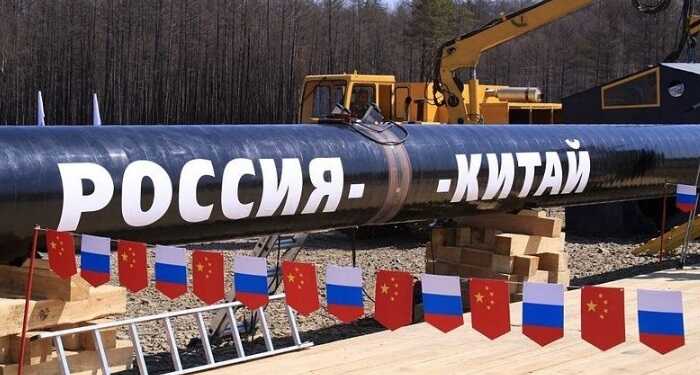
Photo: Bloomberg
ENERGY AND DEFENSE SECTORS
Another significant challenge facing the Russian Federation is increasing oil and natural gas exports to the PRC. The level of oil exports could be increased by expanding the fleet of tankers to transport oil to Chinese ports, but new sanctions against the Russian shadow fleet of tankers may stand in the way.
When the administration of U.S. President Joe Biden imposed large-scale sanctions against Russian oil at the end of its term, 180 tankers of the Russian shadow fleet were blacklisted, the result being that about 60 percent of them (94 out of 154) ceased to be used for transportation of crude oil from Russia. Meanwhile, oil exports to China decreased significantly, but over time, the Russians devised new schemes to allow oil to flow from Russia to Chinese ports again.
Political will of the United States to increase pressure on Russia is key to the fight against the latter’s shadow fleet of tankers. But the current administration in Washington is dragging its feet on expanding and toughening sanctions against Russia, and while this continues, tankers carrying Russian oil have no problems sailing between oil terminals in the ports of China and the Russian Federation.
The situation is more complicated with regard to increasing Russian gas exports to China, as this would require the construction of new gas pipelines. Moscow has suggested its “Power of Siberia 2” project with a yearly capacity of up to 50 million cubic meters of gas. The parties began negotiating this project back in 2014, but its specific parameters still remain unagreed due to the exploitative terms laid down by China, which Russia cannot agree to.
In particular, Beijing is demanding that the Russians lay a pipe to the border with China at their own expense (which exceeds $13.5 billion), so that the route bypass the territory of Mongolia, although this would be a significantly shorter route. The cherry on the cake is that each cubic meter of gas should be priced at the level of internal prices for Russian consumers. The Chinese are not concerned about the payback of the gas pipeline, as this should be a concern for the Russians.
Such unrealistic demands from Beijing regarding the “Power of Siberia 2” are apparently dictated by the complete lack of interest in this gas pipeline. To a large extent, China does not need it, because it will deliver gas to the depressed northern regions of the PRC, where already existing gas pipelines extend from Central Asia, primarily Turkmenistan and Kazakhstan with more predictable and more comfortable ruling regimes for Beijing than Moscow. In the north of China, there is no urgent need for additional volumes of gas, but instead there is a constant need for this resource in the industrially developed South of the PRC, where it does not make economic sense to lay new pipelines across the country to pump additional volumes of Russian gas.
In addition, the Chinese government is pursuing a green transition program aimed to abandon fossil fuels in favor of renewable energy generation. According to this program, by 2030, the country’s natural gas consumption will grow as it replaces coal in thermal power plants. But after 2030 and during the following 20 years, the demand for gas will decrease rapidly, and by 2050, China would slash the use of oil and natural gas, shift residents to electric cars and pull excess carbon dioxide from smokestacks.
However, no one forbids talking about the future of the “Power of Siberia 2” gas pipeline project, which contains impressive numbers and figures, and that’s why it is mostly talked about by the Russians, not Chinese; leaders, under TV cameras, give instructions to accelerate the project’s development, but… They have talked for more than 10 years already and can talk for another decade, and then even Moscow will eventually see the absurdity of this proposal and will slowly forget about it.
But for the Ukrainians, the biggest threat comes from cooperation between Beijing and Moscow in the defense and defense industrial sectors, namely China’s purported intention to transfer to Russia weapons and missiles for use in its “special military operation” in Ukraine. There is no doubt that defense cooperation was a special focus at the talks in Moscow, but the conversation was held behind closed doors. It is apparently for this reason that the Russian delegation to the talks in a narrow circle included Defense Minister Andrei Belousov, Head of the Federal Service for Military-Technical Cooperation Dmitry Shugaev, and Deputy Prime Minister in charge of the Russian defense-industrial complex Denis Manturov, whom, apparently, propagandists deliberately showed in photos and videos.
What could these people have been talking about with their Chinese counterparts in the presence of Xi and Putin, given the already high level of cooperation in military technology between the two countries regarding the export of Chinese components to Russian weapons manufacturers? Some Western analysts suggest that in the presence of the heads of state, they agreed to increase imports from China of tooling machines and components to replace outdated equipment, as well as to outfit new enterprises of the Russian defense-industrial sector.
The talks, perhaps, also covered the reciprocal export to China of Russian weapons and related engineering documentation and manuals, both those that have long been in service with the Russian Armed Forces and new types that came to be during the war, including particularly various types of drones and fiberoptic controlled UAVs as well as systems to counter them. These issues are of priority for both Russia, which is at war with Ukraine, and for China, which is now intensively building up its military muscles, striving to achieve parity with the U.S. military.
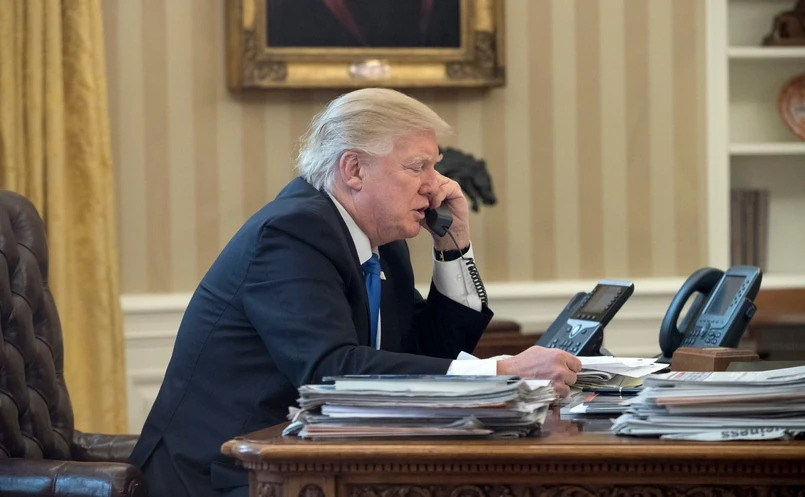
Donald Trump / Photo via AP/EPA
SIGNALS FOR TRUMP
Here we are moving on to the most important part of activities by the Chinese government led by Xi Jinping, which has recently been connected, like many other stories in the modern world, with the person of U.S. President Donald Trump, who from the first days in the White House has been vigorously trying to make friends with the Russian ruler. This does not seem to bother the Chinese comrades much, who are well aware of the difficult situation in Russia, perhaps even better than Putin is, but the overseas attempts had to be stopped and, together with the Kremlin’s owner, it was necessary to clearly explain that Putin’s Russia is inextricably linked to Xi Jinping’s China.
Such a signal was successfully sent in various forms, both in a joint statement by the leaders of China and Russia condemning the attempts by “some countries” to undermine the current multipolar international order, as well as Putin’s excessive zeal for Xi and the widespread veneration of the Chinese leader as the most respected person. It seemed that during Xi’s latest visit to Moscow, all the events in the Russian capital, including the Victory Day Parade, were staged specifically for the Chinese guest. They even provided simultaneous Chinese interpretation of the Parade broadcast and Putin’s speech, which at times sounded higher than the source words in Russian. While in China itself, public television showed only short fragments of the parade featuring Xi on the Mausoleum’s podium and the Chinese military honor guard marching on Red Square and, of course, accompanied by own translation.
So that the other almost 30 country leaders who came to celebrate Putin’s Victory Day had no doubts about who it was all for, the Russian ruler repeated several times that Xi Jinping was his main guest for the Victory Day celebrations. Such a demonstration of the “iron” friendship between the leaders of China and Russia was only intended for one spectator – Donald Trump. The U.S. president was hinted in clear terms that the strategic partnership between Beijing and Moscow is inviolable and Washington’s attempts to distance them from each other are all futile.
China and Russia also sent a message that under no circumstances would they ever yield to pressure from Western countries. This was clearly demonstrated by the columns of Russian troops marching through Red Square, along with all sorts of expensive, deadly hardware ranging from battle tanks to intercontinental ballistic missiles — a matter of special pride for all the Russians.
So the reason for Xi’s presence alongside Putin on Mausoleum podium during the latest Victory Day parade was not at all to celebrate the 80th anniversary of the defeat of Nazi Germany (the Chinese have their own myth about the Victory), but to signal to Trump that China is ready to respond to any attempts to pressure it, whether militarily or economically, or through tariffs. And that Moscow will not hesitate to support Beijing — such an informally legalized alliance of two countries against one – the United States of America.
It would be curious to see whether, after such a blatant display of contempt, the U.S. president will continue to talk about good relations with his Chinese and Russian counterparts, or whether he will finally understand the apparently anti-American nature of their friendship and begin to act in a tough and firm fashion, as an American leader is supposed to.
UKRAINIAN TRACK
It is worth noting that the statements made during Xi’s most recent visit to Moscow and the agreements reached, at least those that the parties have announced publicly, will not have a direct impact on the war Russia is waging against Ukraine. Almost everything that China, being neutral, formally, could do to save Putin from defeat and keep his regime in power has already been done.
Some media outlets saw a sensation in the joint statement by the Chinese and Russian leaders about “eliminating the root causes of the war” as Moscow’s condition for establishing peace, declaring Xi’s support for this far-fetched narrative of Putin. In fact, there is nothing unusual or new in this statement. Chinese Foreign Minister Wang Yi, other Chinese officials and individual experts have previously spoken about the need to “eliminate the root causes.”
The point is in the differences in the meaning the Russians and the Chinese put into these words. For the former, this is one of the fake narratives disguising their wild imperialistic lust to conquer Ukraine, while the latter mean a rejection of “hegemony” and attempts by the West to interfere in the internal affairs of other countries, especially China, which must be resisted.
For Ukrainians, what is important in this whole story is what President Trump will do next, how he will react to the anti-American alliance between Beijing and Moscow after they have laid down an explicit challenge to the United States. With China, as we already know, an agreement has been reached on the postponement of high import duties, progress has been made on some key problematic issues, and there is an expectation of further fruitful work on a major bilateral trade agreement.
With regard to Russia, however, no tangible progress has been achieved yet. Putin offered negotiations without preconditions, but to these negotiations he sent some people tasked not to find a compromise or a settlement, but to persuade the Ukrainians into it and drag out time as long as possible, while Russian troops are swallowing pieces of Ukrainian land one after another. Washington has to make out that this is a plain and repeated trick by the Kremlin and to respond by keeping on and increasing military aid and other support for Ukraine.
If it is difficult to see from across the ocean, there is already a proven way to help see through Putin’s fraud: to invite the President of France, the Chancellor of Germany, the Prime Ministers of Poland and Great Britain to visit Kyiv again and, together with Volodymyr Zelensky, make a call to Donald Trump.
Volodymyr Sydorenko, Beijing
Source: Two against Trump: how China is exploiting Russia in its great game against the USA

